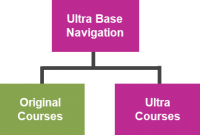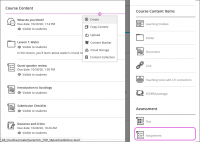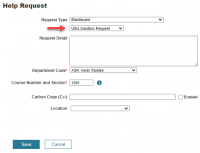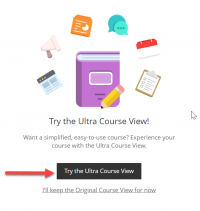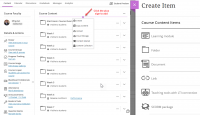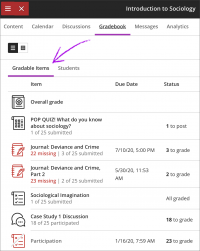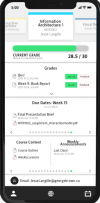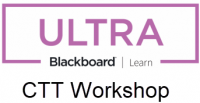Blackboard Ultra: Difference between revisions
| Line 136: | Line 136: | ||
Your course creation starts on the Course Content page. To add content, follow these steps: | Your course creation starts on the Course Content page. To add content, follow these steps: | ||
[[File:AddCourseContent.png|200px|thumb|right|Create a course item]] | [[File:AddCourseContent.png|200px|thumb|right|Create a course item]] | ||
{{#ev:youtube|6GsDkyjhccg|210| | {{#ev:youtube|6GsDkyjhccg|210|left|Add content in Ultra}} | ||
# Select the plus sign wherever you want to add content. | # Select the plus sign wherever you want to add content. | ||
# Select one of the options listed on the drop-down menu (Create, Copy Content, Upload, Content Market, Cloud Storage, and Content Collection). You can choose to create new content, copy content from your existing courses, upload content, or add content from external sources. | # Select one of the options listed on the drop-down menu (Create, Copy Content, Upload, Content Market, Cloud Storage, and Content Collection). You can choose to create new content, copy content from your existing courses, upload content, or add content from external sources. | ||
Revision as of 19:19, 3 December 2022
Blackboard is the William Paterson University’s Learning Management System. Blackboard Ultra is the systems’ most significant change and improvement in terms of functionality and user experience in recent years. To better support teaching and student learning at WPU, the university has begun the gradual transition from Blackboard Original to Blackboard Ultra. The first step of this transition is to enable the Ultra Base Navigation, which we activated in May 2022. The next step is to transition from Original Course View to Ultra Course View. This page is to help the university community smoothly and successfully complete this transition.
What is Blackboard Ultra Experience?
The Ultra Experience is the next generation of Blackboard site and course experiences. It delivers a modern, intuitive, and fully responsive interface, streamlined workflows and capabilities, and a more seamless transition between mobile and desktop.
Blackboard has two user experiences – Base Navigation and Course View - and two user interfaces and workflows – Original and Ultra. Currently, WP deploys Ultra Base Navigation and Original Course View. The next step of our phased transition is to gradually shift from our current format to Ultra Base Navigation and Ultra Course View.
Introduction to Blackboard Learn with the Ultra Experience for Instructors
Introduction to Blackboard Learn with the Ultra Experience for Students
In Blackboard Learn, base navigation is a user interface and the experience a user has outside of a course. The Ultra Base Navigation, which was enabled in May 2022 at WPU, is a new and modern user interface and experience in Blackboard Learn Ultra and a new way of navigating Blackboard. For more about Ultra Base Navigation, please visit our Ultra Base Navigation page.
| Navigation Panel | Ultra Base Navigation Menu Items | Ultra Base Navigaiton Video |
|---|---|---|
|
Profile: Select your name in the list and make changes to your online persona. Activity Stream: See up-to-the- minute action for all of your courses. Courses: Navigate to past, present, and future courses. Organizations: Access the organizations that you lead or are a member of. Calendar: View course events and due dates for all your courses. Messages: View and send messages in all courses. Grades: See what needs grading across all your courses. Tools: Access global functions outside of your courses. |
Ultra Course View
The Ultra Course View is the next generation of Blackboard Learn. While enabling Ultra Base Navigation brings changes outside of course sites only, transitioning to Ultra Course View will have a significant impact on course content, structure, functionality, tools, and navigation inside the course. The Ultra Course View has a more modern design, intuitive and easy-to-use interface, and streamlined workflow with some new tools that are not available in the Original Course View. It helps instructors and students stay organized and easily engage with content and each other.
The screenshots on both sides show the modern and simplified look of Ultra Course View and its streamlined navigation and workflows. For the screenshot on the left: A. Navigation bar. B. Details & Actions. C. Add Content. D. New activities.
Original vs. Ultra Highlights - Click here to see what has changed in Ultra Course View.
Ultra Course View Feature Guide
Course Convertion
Although no date has been set yet by which all courses at WPU will need to transition from the Original Course View to the Ultra Course View, we strongly recommend that faculty get started with Ultra Course View in one or more of their courses.
When you decide whether to adopt Ultra Course View, you might want to take a look at what new features and functions Ultra Course View offers and what tools you currently use in an Original course that are unavailable in Ultra and evaluate how important they are to your transition to the Ultra course. Learn Ultra vs Learn Original Highlights.
You can fully explore your Original course in the Ultra preview before you make the switches and review a list of features and functions that change or won’t carry forward in the Ultra Course View. Please note that you can only convert and preview courses that aren't currently open to students. It is strongly recommended that you do not preview or convert your course from Original Course View to Ultra Course View after it has begun. Instead, please request an Ultra sandbox and then copy your course to the shell.
We will have about 100 Original courses converted to Ultra courses by a vendor. These are mostly the core courses in each academic discipline, courses that have a large number of sections, and WP Online programs that have the most students. Before you proceed with your course conversion, click this link to see whether your course has already been converted.
Request an Ultra Sandbox
All WP faculty are invited to try this out. If you are interested, please click this link and create a helpdesk ticket to request an Ultra Course Preview shell in Blackboard. For "Request Type", choose "Blackboard" on the first drop-down menu and "Ultra Sandbox Request" on the second drop-down menu.
You can use the sandbox to import or copy an existing Original course and explore the features and functions of Ultra Course View. The name of the Ultra Course preview shell is “Course Name-Ultra-your username", which you should be able to find on your course list.
Convert Existing Courses to Ultra Course View
With your Ultra sandbox course shell, you have two-course view options: Original Course View and Ultra Course View. To convert your Original course to an Ultra course, follow the following steps:
- Copy your Original course into your Ultra sandbox course shell. (Click here to see how to copy an Original course into Ultra. Click here to watch a video on course copy in Ultra Course View.)
- When you enter your Ultra sandbox for the first time, you should see a pop-up page as shown in the screenshot on the right.
- If you don’t see the “Try the Ultra Course View” page, click the Pen icon in the upper right corner.
- To explore your Original course in Ultra Course View, click “Try the Ultra Course View!”
- Click the course title, and now you should see your course in Ultra Course View.
Please note that you should see a message in the upper left corner “Welcome to the Ultra Course Preview! Some items aren’t yet supported. View Details.” Here you can review which items, if any, in the original course are not converted and why.
Please also pay close attention to the Blackboard message at the bottom of the screen, as shown in the screenshot!
You can view and explore the Ultra Course View and edit it. You can also switch back to the Original course. However, If you switch back to the Original Course View after you have made changes and edited the Ultra course, changes made during the preview will be lost. Please also keep in mind that once you click “Use the Ultra course,” you CAN NOT go back to the Original course!
Watch a video on how to preview your Original course in the Ultra Course View.
Rebuild Course Content but Copy Assessment
Based on the transition experiences from other institutions, you will get a better result by rebuilding your course fresh rather than converting it from Original. It is recommended that you create a consistent structure using modules first, upload files directly to the course, and copy assessments such as tests and exams from Original to Ultra. CTT has created Ultra course template which you can use to build your course structure.
Watch a video on how to copy course content from Original to Ultra Copy course content from Original to Ultra.
Create a Course from Scratch in Ultra Course View
You can also use the sandbox to build your course directly in the Ultra Course View. You just need to convert your empty course shell (the sandbox) to Ultra using the same way described above.
Use Ultra Course Template
If you teach an online or hybrid course, you can take advantage of the CTT Ultra Course Template to organize your online and hybrid course. This template is structured in alignment with standards of quality for online and hybrid teaching. It uses modules/unit to organize the course, and each module/unit represents a week’s work. The sections in the template can be customized according to the needs of your course and your teaching preferences.
The process of using CTT Ultra Course Template involves downloading the template from a shared folder in WPU OneDrive and then uploading the zip file download into your Ultra Sandbox.
WPU faculty can download the zip files of CTT Ultra Course Template by clicking this link.
Click here to see the Importing a Course Package into an Ultra Course tutorial
Building and Modifying Ultra Courses
Content Creation and Course Design
Create Content Items or Documents
Your course creation starts on the Course Content page. To add content, follow these steps:
- Select the plus sign wherever you want to add content.
- Select one of the options listed on the drop-down menu (Create, Copy Content, Upload, Content Market, Cloud Storage, and Content Collection). You can choose to create new content, copy content from your existing courses, upload content, or add content from external sources.
- To create new course content items, select Create to open the Create Item menu on the right side.
- Choose course content type: Learning module, Folder, Document, Link, Test, Assignment, Discussion, and Journal.
For more information about each of these options, visit this Create Content tutorial
Learning Modules vs Content Folders
You can use either Learning module or Folder as a content container to present and organize your course content. What is the difference between a Folder and a Learning Module in Ultra?
Both can be used to organize course content in a logical and engaging way, but a Learning Module encourages and can force sequential viewing of the items it contains. Learning Modules let students navigate from one content item to the next without distractions, while students need to open and close each item in Folder to access the content. Instructors and students experience modules differently. For students, learning module content is presented sequentially, with navigation arrows that students use to move through the content horizontally. (Instructors can only see this in Student Preview. If your content comprises multiple files for download, a content folder may be the best option. If you want to immerse students in the lesson or concept you're teaching or logically structure a collection of course content – similar to a chapter in a textbook, choose Learning Module.
Blackboard Course Content Tutorials
More tutorials: Batch Edit . Release Content . Best Practices
Create Assignments
Create and Edit Assignments
- On the Course Content page, navigate to the folder you would like to add content to.
- Select the plus icon and click Create in the pop-up menu.
- From the sidebar that opens, select Assignment under Assessment. The new Assignment page opens
- Create your assignment in the Content area.
- Complete the Assignment Settingsincluding Name and Grading. Then select the Save icon on the bottom right to save.
- If you need to edit the Assignment further, click the More Options icon on the right side and select Edit.
Video on Create an Assignment in the Ultra Course View.
Common Questions about Assignment
Click here to see common questions about Assignments:- How do I create assignments?
- How do I grade assignments?
- Can I edit, reorder, or delete assignments?
- A student says they submitted their work but I don't see it. How do I know if they really finished the assignment?
Student Questions about Assignments
Click here to see some of the questions students often ask about assignments in a Blackboard course and the answers to those questions.
Create Tests
Unlike the Original, where you create your tests at Test, Survey, and Pools and then deploy them in the Content area, in Ultra, you create tests where you want to deploy them.
- On the Course Content page, select the plus sign where you want to add a test, then select Create
- On the Create Item panel, scroll down and select Test under the Assessment section
- On the new Test page, name your test.
- To add new questions, select the plus sign and choose the desired question type. You can also add files and text, such as instructions for the test.
- Set the point value for each question you create.
- Select the Test Settings (gear) icon to open the panel where you can set test options and provide the test's details and information.
Watch a video on how to create a test in the Ultra Course View
Blackboard Help page - Create Test
Common Questions about Test
Grading and Gradebook
Where Do I Start Grading?
In Ultra, most grading functions are available in the Gradebook. The Needs Grading view in Original is discontinued. Gradebook in Ultra provides grading indicators in the Activity Stream and on the list view of the Gradebook.
Access Gradebook
You can access Gradebook in two different ways:
- Click Grades on the Base Navigation panel on the left, and you will see everything that needs grading in all your courses on the global grades page. All your grading tasks are organized by course, and courses appear in alphabetical order. Click the course title to open the Guidebook.
- Within a course, you will have access to the Gradebook from the Gradebook tab on the navigation bar.
Gradable Items List and Student List
The Gradebook is populated with students when they're enrolled in your course. You can grade coursework, manage items, and post grades from two views:
- Gradable Items List
- Student Grid
The default Gradebook view is a list of the graded items. You can view all the coursework you've assigned and your grading progress. You can also change the settings of the Gradebook.
Gradable items are automatically created when you create gradable items in the course content area. But you can select the plus sign wherever you want to add the following to the Gradebook:
- Add Item
- Add Calculation
- Add Attendance
Add Item can be used for manually added grade items, such as participation, extra credits, etc. For manually added items, no submissions exist. You assign scores and feedback on the student list page.
You can also add attendance on the main Gradebook page. Select the plus sign wherever you want the attendance row to appear in the list and select Add Attendance.
Grading
In Ultra, you can choose where you want to start grading. You can start your grading from:
- Activity Stream on the navigation panel
- Grades on the navigation panel
- Gradebook on the navigation bar within the course
- Assignment within the course
Click Activity Stream on the navigation panel, you can see how many assignments are ready to grade in all your courses.
Click Grades on the navigation panel on the left, you will see the global grades page, where you have immediate access to all your courses's grading tasks. All your grading tasks are organized by course. You can quickly scan your progress, set priorities across the board, and even begin grading. No need to navigate to each course to see what's ready for grading.
The page only displays information if you need to take action. You see assignments that are ready to grade or which assignments are overdue for how many students.
If you wnat to narrow your focus on a particular course, you can access the course Gradebook on the navigation bar within the course. In Ultra, most grading functions are available in the Gradebook. The Needs Grading view in Original is discontinued. Gradebook in Ultra provides grading indicators in the Activity Stream and on the list view of the Gradebook.Click Gradebook, you can see who has made submissions and start grading.
You can also start garding from an assignment.
Blackboard offers streamlined grading. The system tells you when students have submitted test and assignment by notifying you in the Activity Steam. A simple click will bring you right into the assessment where you can see who has submitted, who is late, and what has been graded. The submission and assessment is always tie together, so you can access both whenever you open the assessment.
To start grading,
- Select an item’s title to see what students’ submissions need grading and which haven’t received their grades yet.
- Inside the submissions list for a gradable item, use the Filter menu to display only those submissions that need grading. You can filter by "All Grading Statuses," "Needs Grading," "Needs Postin," etc.
- Click student's submission to grade.
You can switch to the Students tab to view an overall picture of each student’s engagement. And the Student grid view is similar to the Grade Center in the Original Course View.
Inline Grading with Bb Annotate
Overall Grade
Gradebook Settings
You can switch to the Students tab to view an overall picture of each student’s engagement.
In Ultra Course View, you can automatically assign zeroes (0) for assessments that are not submitted by the due date.
Grades are not visible to students by default in the Ultra Course View; you use Post when you have grades ready for your students to see. Overall grade now supports weighted, points-based overall grade calculation and advanced calculation.
Blackboard Tutorial on GradingCommunication
Blackboard Instructor App
Blackboard now offers a unified Blackboard app for both instructors and students. And Blackboard's support for the previous Blackboard Instructor app ended on September 30, 2022. For more information about the app, visit Blackboard App Help.
As an instructor, you can perform these tasks in the Blackboard Learn app:
- Preview course items, assignments, and tests
- Create and upload course content
- Participate in discussions
- Send announcements
- Grade assignments and update assessment settings
- Change item settings for assessments and other content
- Work with both Original and Ultra courses
Getting Help
Tutorials, Guides, Webinars
- Blackboard Learn Help for Instructors - Ultra Course View
- Blackboard Ultra Video Playlist
- Anthology/Blackboard Community The Community is a platform for Anthology/Blackboard users to connect, share knowledge and information, and collaborate. It is a place for Blackboard users to help and learn from each other.
- Instructor Webinar Series This Blackboard site provides ongoing free webinars to help with getting the most out of teaching with Blackboard Learn.
- "Blackboard App" help page Blackboard Instructor is a mobile app that enables you to view the course content, modify settings, grade assignments, connect with students in discussions, and launch Blackboard Collaborate sessions.
Trainings and Workshops
Blackboard Ultra Institute
The Center for Teaching with Technology offers Blackboard Ultra Institute, which is an opportunity for faculty to get an early look at the changes that are coming. So far, we have offered three times since October 2022. Two more have been scheduled on the following dates:
- November 28 and 30, remote.
- January 9 and 11, 2023 (Monday and Wednesday), in person.
All faculty are welcome, but space is limited for in-person sessions, and registration is required. Stay tuned for further announcements. Click here to see the CTT Blackboard Ultra Institute accnouncement.
Blackboard also offers some wonderful webinars on Ultra. Instructor Webinar Series This Blackboard site privdes ongoing free webinars to help with getting the most out of teaching with Blackboard Learn.

